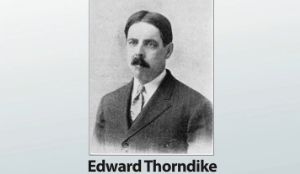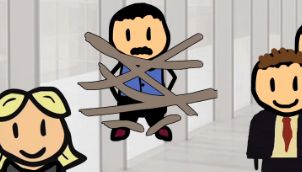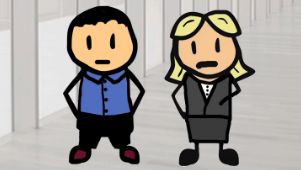Thorndike's Reinforcement Theory: Using Consequences to Motivate Employees
After you watch the video and know the material, click HERE for the quiz.
In the workplace, there are levels of acceptable behavior. As a manager, it is important to use appropriate techniques that reinforce acceptable behavior and deter inappropriate behavior. This lesson describes how reinforcement theory is used to influence employee behavior through consequences.
Thorndike's Reinforcement Theory
It is Ryan's first day at his new job at StopMommy.com, and he's waiting for his manager to take him on a tour of the facility. Ryan's manager, Jessica, greets him and explains that he may see some unusual things on the tour but that she will explain everything to him along the way. Jessica begins the tour by showing Ryan a picture of the man Edward Thorndike who deeply inspired the founder of StopMommy.com. She explains that Thorndike was a psychologist who in 1911 developed the law of effect, which states that behavioral responses to stimuli that are followed by a satisfactory response will be strengthened, but responses that are followed by discomfort will be weakened. Essentially, behaviors that are rewarded are often repeated, and those behaviors that are not rewarded are less likely to occur in the future. This law of effect was later translated into a theory of employee motivation known as reinforcement theory, which Jessica clarifies as a theory that looks at the relationship between behavior and its consequences.
 |
 |
Positive Reinforcement
After explaining reinforcement theory, Jessica begins introducing Ryan to some of his coworkers and showing him where his new desk will be located. Jessica then leads Ryan down a long hallway and points to a door with the words 'Positive Reinforcement' written on it. Jessica asks Ryan to open the door, which made Ryan a bit nervous. However, what was on the other side of the door quickly brought a smile to Ryan's face. On the other side of the door lay the mother of all break rooms. There were some employees getting a massage, plush pillow-top beds to take a nap on, a full service bar, a chef who would cook any dish you wanted. There was coffee that brewed every five minutes to ensure maximum freshness, and there was even a unicorn that you could ride! Jessica explained to Ryan that this was the room of positive reinforcement, and anytime he does something that she believes is desirable, he can enter the room of positive reinforcement.
 |
Negative Reinforcement and Avoidance
Jessica closed the door to the room of positive reinforcement and then points Ryan to another door marked 'Negative Reinforcement and Avoidance'. Ryan opens this door and lets out a scream. Unlike the room of positive reinforcement, this room was unpleasant, smelled of fish, was full of trash, had only a vending machine, the coffee looked as if it were five days old, there were no tables or chairs, and in place of the unicorn was a broken-down kiddy ride in the shape of a horse. Jessica explained to Ryan that this was the room of negative reinforcement and avoidance, and anytime that he does something that she believes is less than desirable, he will be sent to the room of negative reinforcement and avoidance. She explains that this is not a punishment, but rather a reminder to him to always strive to exert desirable behaviors, or he will not be allowed into the room of positive reinforcement. When someone cannot enter the room of positive reinforcement but needs to use the break room, they will have to settle for the room of negative reinforcement and avoidance.
Negative reinforcement, or avoidance, is used by managers to show an employee what the consequences of unacceptable behavior will be. The goal is to get the employee to avoid the unacceptable behavior. If an employee does not engage in the unacceptable behavior, then he or she will not experience the consequence.
 |
Punishment Through Negative Consequence
As Jessica and Ryan continue their tour, a group of employees grab Ryan and duct tape him to the wall. It appears the employees at StopMommy.com like to haze new employees as a means of welcoming them to the company. This is something that Jessica has advised her employees not to do. Jessica immediately tells the employees to stop their behavior. She then turns and informs them that they will all be docked pay for the day because of their actions. As Jessica begins to remove Ryan from the wall, she tells him that this should serve as a lesson to him that inappropriate behavior can result in punishment at StopMommy.com. Jessica suspects that those employees will refrain from engaging in this type of hazing activities going forward because of the punishment.
Punishment is used by managers to decrease the probability of an inappropriate behavior being repeated by employees. Examples of punishments include docking pay, demotions, threats, suspensions, and the loss of employee perks. Punishment essentially applies negative consequences for undesirable behavior. Remember, a person is punished in the attempt to decrease the probability of a behavior being repeated, whereas negative reinforcement is used to increase the probability of a desired behavior being repeated. Many believe that punishment, though extremely popular, should only be used if positive and negative reinforcement cannot be used or have failed previously.
 |
Extinction is Sometimes Best but Not Always
Ryan tries to cover for his coworker and get Jessica to reconsider the punishment. Jessica tells Ryan that she has tried to be lenient on this group before, but it has clearly not worked. She tells him about an incident last week where they ambushed a new employee with spitballs on his way to the bathroom. Jessica told the new employee that boys will be boys and to just ignore the behavior as it was not typical of them. Now that the incident was happening again, Jessica needed to punish the behavior so that it no longer occurred.
Extinction occurs when a manager ignores unacceptable behavior. Extinction is similar to punishment in that its purpose is to decrease the probability of unwanted behavior. Neither positive nor negative reinforcement is used in hopes that the behavior will resolve itself. However, managers must be especially careful using this technique and be certain that the behavior is temporary, unusual, and not serious.
 |
Lesson Summary
Let's review. Edward Thorndike was a psychologist who in 1911 developed the law of effect, which states that behavioral responses to stimuli that are followed by a satisfactory response will be strengthened, but responses that are followed by discomfort will be weakened. Essentially, behaviors that are rewarded are often repeated, and those behaviors that are not rewarded are less likely to occur in the future. This law of effect was later translated into a theory of employee motivation known as reinforcement theory, which is a theory that looks at the relationship between behavior and its consequences. The defining factor of reinforcement theory is, of course, reinforcement which can be either positive or negative. However, because positive and negative reinforcement do not always work, there are two other reinforcement strategies that can be used, including punishment and extinction.
Positive reinforcement uses favorable consequences that reinforce the desired behavior as the correct behavior. It is used to reward desirable behavior with the intent of increasing the likelihood that the pleasing behavior will be repeated. Examples of positive reinforcement include pay raises, bonuses, promotions, awards, and public recognition. In the workplace, managers can use positive reinforcement to increase productivity and improve the employee or department morale.
Negative reinforcement, or avoidance, is used by managers to show an employee what the consequence of unacceptable behavior will be. The goal is to get the employee to avoid the unacceptable behavior. If the employee does not engage in the unacceptable behavior, then he or she will not experience the consequence.
Punishment is used by managers to decrease the probability of an inappropriate behavior being repeated by employees. Examples of punishments include docking pay, demotions, threats, suspensions, and a loss of employee perks. Punishment essentially applies negative consequences for undesirable behavior. Remember, a person is punished in the attempt to decrease the probability of a behavior being repeated, whereas negative reinforcement is used to increase the probability of a desired behavior being repeated.
Extinction occurs when a manager ignores unacceptable behavior. Extinction is similar to punishment in that its purpose is to decrease the probability of unwanted behavior. Neither positive nor negative reinforcement is used in hopes that the behavior will resolve itself. However, managers must be especially careful using this technique and be certain the behavior is temporary, unusual, and not serious.